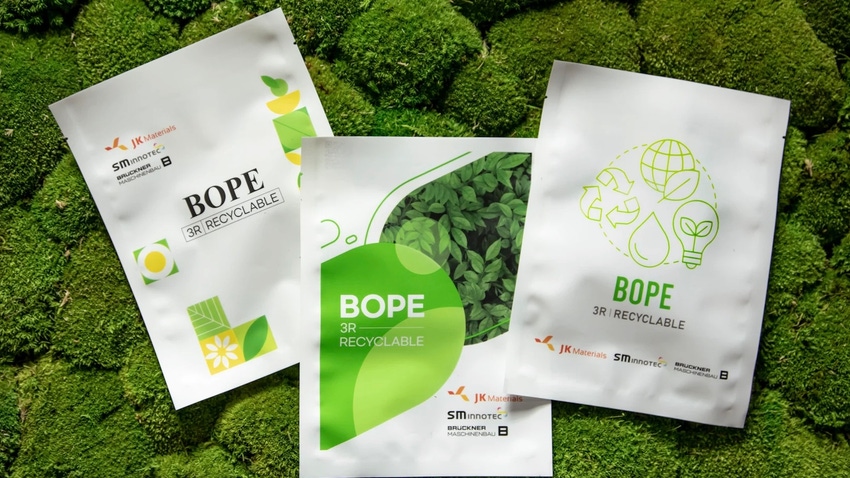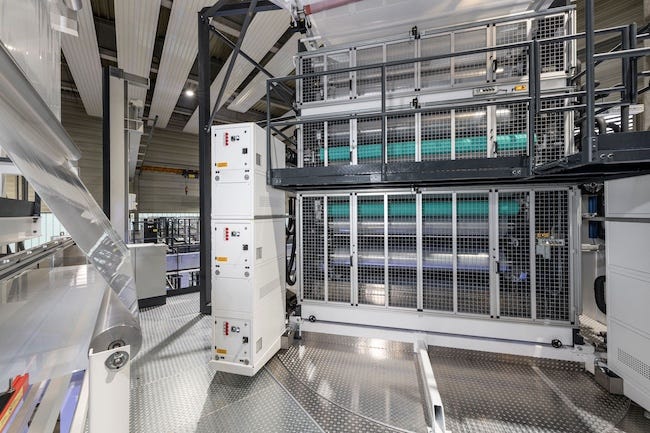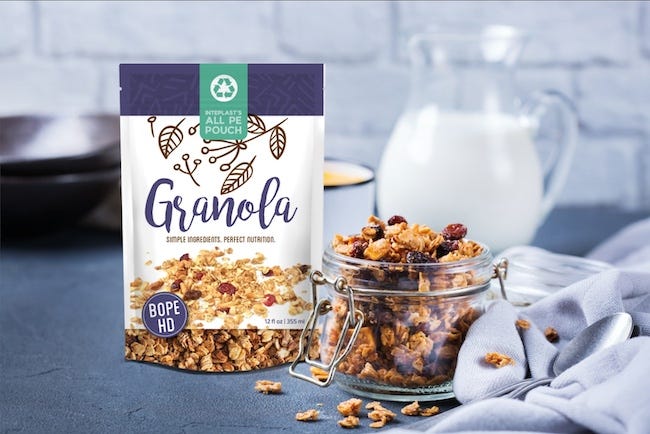Mono-material Packaging Structures Gather Momentum
Converters team up with materials suppliers and machinery manufacturers to fine-tune performance, productivity in easy-to-recycle flexible packaging structures.
April 1, 2024

At a Glance
- Stretchable HDPE development a key enabler in realizing stiffness
- MDO and BOPE conversion processes both have roles to play
- Standup pouches are a standout flexible packaging format
Mono-material flexible film packaging structures based primarily on polyethylene (PE), polypropylene (PP), or even polyethylene terephthalate (PET) are being promoted as an effective means of accelerating mechanical recycling initiatives, even if they are typically co-mingled with mixed plastic waste at present upon disposal. Looking at recent developments in materials as well as increasing numbers of conversion machines in the field that are capable of stretching PE either in one direction or biaxially, it does appear as if these mono-material structures increasingly will be adopted as readily recyclable flexible packaging, as long as appropriate collection systems are in place.
BOPE versus MDO
The two key enabling processes for replacing multi-material packaging formats with mono-material alternatives are biaxially-oriented PE extrusion/stretching of cast film and machine direction orientation (MDO) stretching of blown film. These processes stretch special grades of high-density PE (HDPE) in combination with linear-low-density PE (LLDPE) to impart sufficient stiffness to the structure, whereby the HDPE can replace the BOPP or oriented polyamide (BOPA) or oriented PET (BOPET) layers normally employed. Mono-material structures also must be produced that accommodate print and incorporate sealant layers.
MDO-PE blown film line supplier Reifenhäuser has close to 30 of its Ultra Stretch MDO units in the field globally. Sascha Skora, senior sales manager for blown film at Reifenhäuser, says the main difference between MDO and BOPE is in line output. “BOPE lines have a much higher capacity, so the customer must have a large supply demand,” he notes. Further, “MDO for blown film lines is more cost-effective, can be retrofitted, and is also more flexible,” he claims. “Performance-wise, elastic moduli of 800 to 2000 MPa (MD) and 800 to 1700 MPa (TD) can be realized,” adds Skora.

The MDO process is highly suited to flexible production of low-volume, tailored mono-material packaging. Image courtesy of Reifenhäuser.
Meanwhile, materials supplier Nova Chemicals expects BOPE-HD to deliver enhanced puncture resistance in applications that are exposed to a higher level of abuse or drop impact and that also require high-quality printing.
In a written reply to questions from PlasticsToday, Nova Chemicals agreed that scale is important when comparing the two technologies. “MDO-HD is generally produced on co-extrusion blown film lines, thus there is a flexibility in the structure design that allows processors to optimize or accentuate specific properties. We believe that MDO-HD will allow processors to tailor the structure design for more-specific applications and would be good for small runs, or very specific applications that have lower impact requirements,” the company notes. “BOPE-HD film produced on large-scale equipment will have the economy-of-scale advantage over MDO-HD, but may require more broad-use cases to justify a particular design.”

BOPE-HD structures deliver enhanced puncture resistance while offering opportunities to downgauge. Image courtesy of Nova Chemicals.
Downgauging with BOPE
BOPE line supplier Brückner Maschinenbau is active in the mono-material market with hybrid lines that are equally capable of converting PE and PP structures. A total of almost 20 such lines are either currently operational or to be installed over the next year or so, according to the company. Brückner offers options with 26,760 or 40,000 tonnes of annual output, and converters can switch between production of PE and PP structures as they start developing and building on production of all-PE applications in order to maximize capacity utilization. Current resin performance attributes mean a die-change may be required when switching between the two resins, as HDPE cannot be stretched to the same degree in the transverse direction as PP, according to Karl Zimmermann, director of sales and marketing at Brückner.
Besides excellent mechanical performance, a key advantage of the biaxial process is the ability to downgauge, according to Zimmermann. “If you typically use a 50- to 60-micron [oriented] blown film structure with an LLDPE sealant, you can achieve the same objective with a 30-micron biaxial film.” This is an advantage when considering that stretchable HDPE grades currently command a hefty price premium.
Materials of interest
Stretchable HDPE is a key requirement of PE mono-material structures, and Nova Chemicals is one of the suppliers at the forefront of material development for both the MDO and BOPE processes. Central to its efforts in the BOPE segment is Surpass TX150, a grade that was developed to be viable on existing commercial tenter frame lines that currently produce BOPP films. “To do this, we designed TX150-A to have a viscosity similar to PP grades designed for the biaxial orientation process,” a company official stated.
Nova Chemicals concurs that hybrid lines are the latest technology and do provide the most flexibility when producing BOPE films, but with a few key upgrades an existing tenter frame line is perfectly suitable for BOPE-HD film manufacturing. “These upgrades or modifications are essential but manageable and don’t impact the existing production of BOPP.��”
Brückner’s Zimmermann says when a converter is looking to upgrade an existing BOPP line to also convert PE, an audit should be carried out first. “We look into the age of the line, mechanical limitations, and also control system limitations, given a lot of progress has been made over the past 20 years.”
Application standouts
In terms of applications, the focus to date has been on three different types of high-density films — high clarity, matte, and sealable BOPE films, according to Nova Chemicals. “The applications range from standup pouches for dry goods and candies to vertical bags for frozen food to pet food packages and most recently for flow wrap applications for candy or snack bars.”
“The largest opportunity for BOPE-HD film is to replace BOPET, which is currently used to create non-recyclable mixed-material packaging such as standup pouches. We have worked with [form-fill-seal line equipment suppliers] Totani and Effytec to thoroughly test BOPE-HD-based packaging on both pre-made pouch lines as well as in-line HFFS lines, so we know that BOPE-HD is well suited for standup pouch applications,” says a Nova spokesperson.
“Beyond pouches, brands have largely already tackled the multi-material packages that were easy to convert for recyclability purposes. Where BOPE-HD fits in is to achieve success with the harder-to-transition packages, which have high performance needs, especially in toughness, heat resistance, and optics, that continue to exist on store shelves in a non-recycle-ready format today.”
About the Author(s)
You May Also Like




